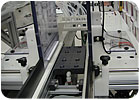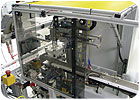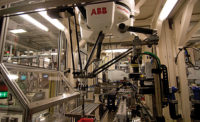
Think your manufacturing company is too small or underresourced to automate? Think again. With a new approach toward infrastructure efficiency, results-oriented employees empowered to work across technical disciplines, and a flexible hands-on project management style, amazing results can be achieved with a small budget and a few key individuals.
In contrast with the traditional approach of automating with the help of a systems integrator, the low-cost automation strategy relies on in-house resources that grow concurrently with the project and are ultimately integrated into the company infrastructure upon completion of the project.
Our approach to low-cost automation involves six steps:
• Choosing co-champions for the project.
• Determining the scope of the project.
• Building infrastructure to support it.
• Building the system.
• Debugging.
• Validating the process and deploying the system.
Choose your co-champions. This is the start of building an in-house automation infrastructure. Total responsibility for the project should be divided between two individuals. One will assume responsibility for design, fabrication and maintenance; the other will take responsibility for the completed system once it’s delivered to production. Each person should be willing to wear numerous hats within the organization and do whatever it takes to get things done.
Determine the scope of the project. This includes determining the processes to be automated, the sequence of operations, the minimum level of automation and control for each process, the minimum level of material handling between each process, and the target throughput rate.
This is fairly typical for any automation project, with the exception that an emphasis is placed on identifying the minimum criteria for the overall system. The goal is to prevent unnecessary features from working their way into the project. To keep costs low, the content of the project must be steadfastly guided by what is absolutely essential without regard to other considerations, such as supplier promotion of new products, convenience features, and CIM architecture that is out of scale with the target operation.
Build infrastructure to support the project. Start by creating areas for fabricating and assembling parts, subsystems and entire machines. This would include a machine shop, controls fabrication area, and stock room for consumables, fasteners, pneumatic components and electrical panel supplies.
These areas should be laid out with the objective of supporting the project and the finished system. The cost of setting up a basic machine shop and adjacent work areas is relatively small compared with a typical manufacturing automation project, especially if some effort is made to bargain-hunt for just the right machine tools, support equipment and shop supplies.
Build the system. By assigning a small “A team” of engineers to take on major tasks within the project, the productivity of the entire project staff goes up considerably, compared with the traditional organization structure, in which each engineer specializes in a specific discipline.
The downside of the traditional approach is that each specialized engineer only works on the system for a fraction of the total project time. That leaves lots of room for low productivity if there isn’t a steady flow of projects to be worked on. In contrast, an A team capable of working in various engineering areas and technical trades remains completely engaged in the project during the entire process, shifting from one engineering discipline to the next as the project progresses and working in various technical trades as needed.
It’s crucial to pick the right engineers for the A team. Ideal candidates will have experience designing mechanical, electrical and software systems, and they shouldn’t be afraid to get their hands dirty fabricating parts in a machine shop, installing pneumatic components, or wiring a control panel before programming the PLC.
Debugging. The system’s control software is the last major step to be completed in an automation project. Because it’s flexible and easily modified, the software often ends up “fixing” many issues uncovered during debugging and testing.
With the low-cost automation approach, it’s likely that the person writing the control software was also heavily involved in designing the system’s mechanical and control elements. As a result, he can implement far more insightful solutions to problems than simply trying to fix things with the software.
Let’s say that, while writing ladder logic for a PLC, an engineer determines that a mechanical actuator is not moving correctly and is causing repeatability issues. The solution is simple: Take a break from programming, remove the actuator, modify it in the machine shop, document any changes made to the part, reinstall it, and then go back to programming. The idea is to keep workflow on the system going all the time, with seamless transitions from one engineering discipline or technical trade to another as each problem is resolved.
Process validation and deployment. This stage is where the production co-champion is in the spotlight, ushering the new automated system into production. This is also the stage where the partnership between the co-champions gets tested the most, as deadlines loom, technical issues resist resolution, and consumers scream for the new product to be assembled on the system.
After deploying the system, the design co-champion should focus on any remaining documentation issues, spare parts procurement and maintenance protocols, while the production co-champion focuses on yield numbers, throughput, operator training and piece-part issues.

In contrast with the traditional approach of automating with the help of a systems integrator, the low-cost automation strategy relies on in-house resources that grow concurrently with the project.
Maintenance Benefits
Compared with the traditional specify-buy-implement strategy, the low-cost automation strategy provides several benefits.One of the most visible benefits of the low-cost automation strategy is the development of an expert equipment maintenance infrastructure. From the start, maintenance responsibilities for the finished system should be assigned to the engineering staff that designed and fabricated it. This is a powerful motivator to get things right during design and fabrication, since there will be no one to whom engineers can hand off unresolved equipment “headaches” at the end of the project.
It also eliminates the need for maintenance and operation training, since the staff that built the system will gradually become experts in running it during the course of the project. In addition, the engineering staff is readily available for emergency repairs or software changes. They have access to the complete design file for hunting down various design details, dimensioned drawings, purchase orders, vendor documentation, and special fixtures and jigs created for the project.
Tasking the engineering staff with maintenance ensures that repairs are carried out consistent with the standards used when the system was originally built. This maximizes the lifespan of the system and minimizes downtime.
Finally, when the engineering staff is directly involved in maintenance, a huge amount of technical expertise can be brought to bear to resolve problems quickly and accurately. Depending on the size of the project, this approach also saves money over the long term compared with the traditional approach to buying and implementing automation. In the traditional approach, maintenance responsibilities are thrust upon nonengineers who have been given accelerated training on the system at the very end of the project cycle. They have limited exposure to the project design file and control system.

To keep costs low, the content of the project must be steadfastly guided by what is absolutely essential without regard to other considerations.
Labor Efficiency
A less obvious benefit of the low-cost automation strategy is the efficiency boost from sharing responsibility for the project and minimizing the amount of dedicated supervisory and technical staff. This creates a lean organization where everyone is a key contributor and everyone is empowered to make decisions to keep the project moving forward. Layers of labor that do not directly contribute to the project are eliminated. Everyone on the team is allowed to do any task they are proficient at (regardless of their title).Better still, this results-oriented philosophy persists between automation projects. The collective talents of the engineering staff can be applied to documentation, technical writing, new technology investigation, process development, yield improvement, calibration and instrumentation, skills development, and maintenance. The goal is to keep the engineering staff challenged, while giving them freedom to broaden their skills.
To get the most out of the low-cost automation strategy, it’s important to foster a culture that promotes small-scale innovations from everyone on the project staff. Encourage everyone to constantly examine problems and improve designs to boost system performance. It should never be too late to implement a good idea or refine a design strategy if it will genuinely improve the system.
In contrast, when a custom automated system is purchased from an outside supplier, constant design changes are not encouraged-for good reason. Change orders incur an increasing cost penalty the later in the project they occur.
The ability to accommodate design changes is especially helpful when novel processes are automated for the first time. Despite the best efforts to perfect every process before it gets automated, there will undoubtedly be a need to refine a part or process step before the project is completed.
Another benefit of the low-cost automation strategy is the expanded thinking period that usually occurs before projects formally start. This is the time between when the engineering staff becomes aware of future automation projects and when each project officially starts. This head start allows everyone on the team to casually think about system designs, make napkin sketches of ideas while at lunch, and informally discuss designs amongst each other. The net effect is a design convergence, yielding refined ideas right from the beginning of the project.
Compared with the traditional approach, the low-cost automation strategy can save money in many other ways:
• Reduced travel expenses for progress meetings.
• Simplified literature and documents, since the automated system is not being “sold” to an outside customer.
• Reduced expenses for sample parts. Because there is less need to hold onto bulk quantities of parts for the duration of the project, parts can be acquired as needed.
• Reduced finance expenses associated with making a few large payments at project milestones vs. multiple incremental payments for in-house purchases and labor.
ASSEMBLY ONLINE
For more information on assembly automation, visit www.assemblymag.com to read these articles:•Budde on Assembly Automation: What Makes a Good Specification?
•Do It Yourself Automation.
•Automation as a Competitive Advantage.
